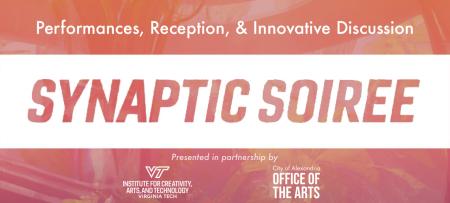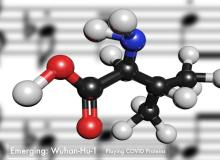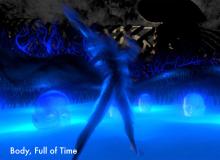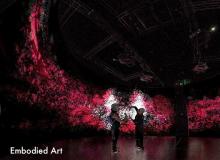Synaptic Soiree
Synaptic Soiree Event Information

Celebrate the beginning of a yearlong artistic collaboration, Innovation & Creativity, with Synaptic Soiree
-
Dates
- September 16, 7 - 10 p.m.: Register Now, Space is Limited and Registration is Required
- September 15, 7 - 10 p.m: Invitational only. Email brett.johnson@alexandriava.gov with questions.
-
Location
-
Torpedo Factory Art Center (105 N Union St). Parking
-
-
Event Details
Synaptic Soiree is an evening of party and performances featuring three intriguing projects from ICAT's vibrant teams of researchers and artists, curated for the City of Alexandria and Northern Virginia audience.
The evenings performances push the limits of sound and performance; they will explore scored data composed of music exploring infectious diseases, neuroscience, including Atrium, meditation, PTSD, and more, as well as the juxtaposition of new technology and the human body.
This evening marks the official launch of Sound Horizons, an exhibition in Target Gallery at Torpedo Factory Art Center and the first collaboration between ICAT and the Office of the Arts. Guests may experience the exhibition during the event.
Performances shall start at 7:30 pm and end at approximately 8:45 pm. A facilitated discussion and reception with light food and drink will follow the end of the performances.
The City of Alexandria, VA’s Office of the Arts and the Institute for Creativity, Arts, and Technology (ICAT) at Virginia Tech in Blacksburg, VA have partnered to present Innovation & Creativity. The partnership is an extraordinary yearlong artistic collaboration culminating with the inauguration of the new Virginia Tech Innovation Campus in the Potomac Yard area of the City of Alexandria in Fall 2023.
Performances

Emerging: Wuhan-Hu-1: Playing COVID Proteins
Performed by flute, clarinet, violin, cello, and computer, composer Charles Nichols collaborated with molecular biologist Deborah Good and graduate student Shannon Mauro to sonify the spike protein of the COVID-19 Wuhan-Hu-1 virus. He started by converting the side chains of twenty amino acids, that link to form the proteins, into musical motives. By employing the same musical cryptogram systems that Bach, Schumann, and Ravel used to translate names into pitches, Nichols mapped the chemical symbols of the skeletal formulas to notes of different pitches. Working across the ball and stick model of each amino acid, if a side chain branches, the notes of the musical motive transpose up and down in pitch. To add rhythm and articulation to the notes, the higher the element in the side chain appears on the periodic table, the longer the rhythm sustains and the stronger the articulation stresses the corresponding note. To sonify more of the spike protein data and increase musical interest in the sequence, the folding behavior of the amino acid, whether it causes the protein to helix, coil, or sheet, determines the overlap of the musical motives across instruments, and the amount of glycosylation determines the pitch transposition of sections. Artist Bios

Body, Full of Time
"Narcissus" is a solo choreographic work performed and created by movement and media artist Scotty Hardwig in collaboration with visual artist Zach Duer, and sound score by Caleb Flood. Using motion capture, projection, and interactive avatar designs, the work presents a chimeric vision of the human body fragmented in the cyber age, examining the relationship between physical and digital versions of self. The dance emerges in the space between the human and the virtual, with the body both as active sensor and passive recipient to technological currents. This work has been adapted from the original version which included animations by Nate King, and scenic and costume designs by Estefania Perez-Vera. Artist Bios

Embodied Art
A guide through the intricate dynamics of human brain activity that represent our emotional states as we interact with others. Using data sonification and projection mapping, the work represents two key measurements of brain activity: electricity and blood flow. The principal dancer wears an electroencephalography (EEG) cap that measure their electrical brain activity throughout the performance. This same brain activity will be sonified in real-time and produce music that will showcase different mental/emotional states as they meditate and engage in solo and interactive movement experiences. Meanwhile, the physical movement of the dancers will be represented through a projection of blood flow within the brain, akin to the workings of functional magnetic resonance imaging (fMRI). The performance highlights different ways to understand complex neuroscientific data through artistic representation. Artist Bios
Thank You to Our Sponsor

Thank you to our sponsor, Hilton Alexandria Mark Center!
SPONSORSHIP OPPORTUNITIES
Are you interested in getting involved with the Innovation & Creativity exhibition? Download our Sponsorship Opportunity PDF or contact Brett John Johnson at brett.johnson@alexandriava.gov